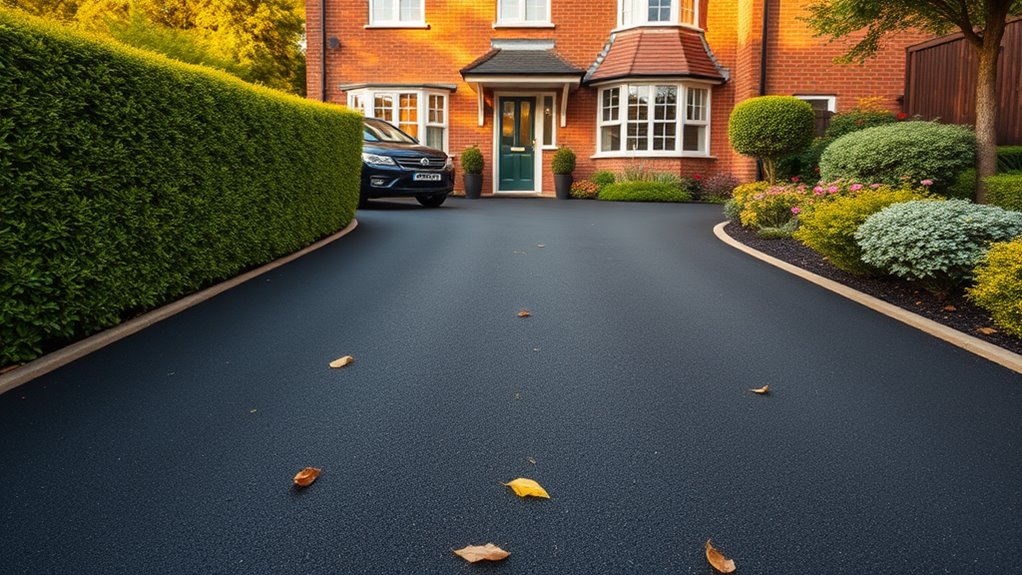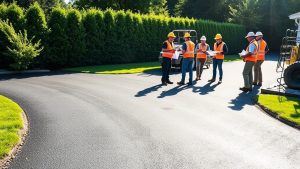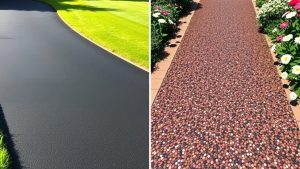Using recycled tarmac for driveways can save you 30-50% compared to traditional asphalt, all while supporting a circular economy and conserving natural resources. It’s just as durable as new asphalt, looks great, and performs well in different weather conditions. Plus, maintenance is typically easier and cheaper. This approach also helps reduce carbon emissions and cuts down on landfill waste. To learn more about installation best practices and upcoming trends that enhance the benefits of this eco-friendly option, keep reading.
Table of Contents
ToggleKey Takeaways
- Recycled tarmac is a cost-effective option, offering savings of 30-50% compared to new asphalt, making it an attractive choice for budget-conscious homeowners.
- It’s environmentally friendly, conserving natural resources, reducing landfill waste, and lowering carbon emissions, which supports sustainability.
- Recycled tarmac is durable and resilient, performing well under harsh weather conditions and heavy traffic, matching the longevity of traditional asphalt.
- Its textured surface helps with snow melting and reduces flooding, while good drainage enhances its performance in various weather scenarios.
- Regular maintenance is simpler and more affordable, ensuring that recycled tarmac driveways last longer than those made with traditional materials.
Cost-Effectiveness of Recycled Tarmac
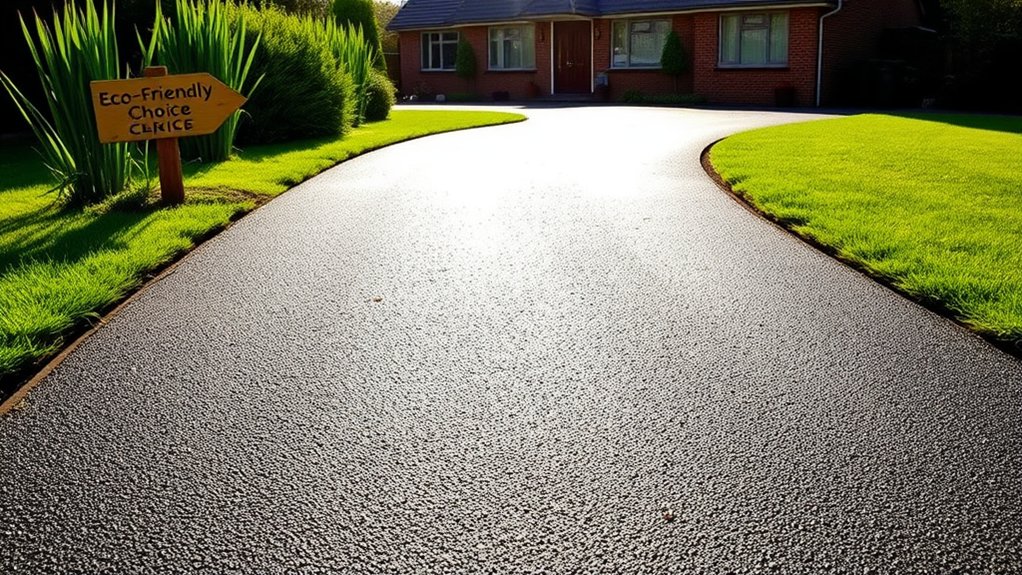
When planning a new driveway, choosing recycled tarmac can save you a considerable amount of money. Typically, recycled asphalt costs between £50 and £80 per tonne, while new asphalt can exceed £250. This price difference can result in savings of 30-50% for your project.
By using recycled materials, you lessen the need for costly virgin resources and cut down on transport expenses. Moreover, processing recycled asphalt on-site reduces labour costs and speeds up installation. The production process begins with grinding old pavement into smaller pieces, which contributes to the cost-effectiveness of recycled tarmac.
The durability of recycled tarmac means you’ll likely spend less on maintenance in the long run. Overall, opting for recycled tarmac is a smart, cost-effective choice that benefits both your budget and the environment.
Environmental Benefits of Using Recycled Materials
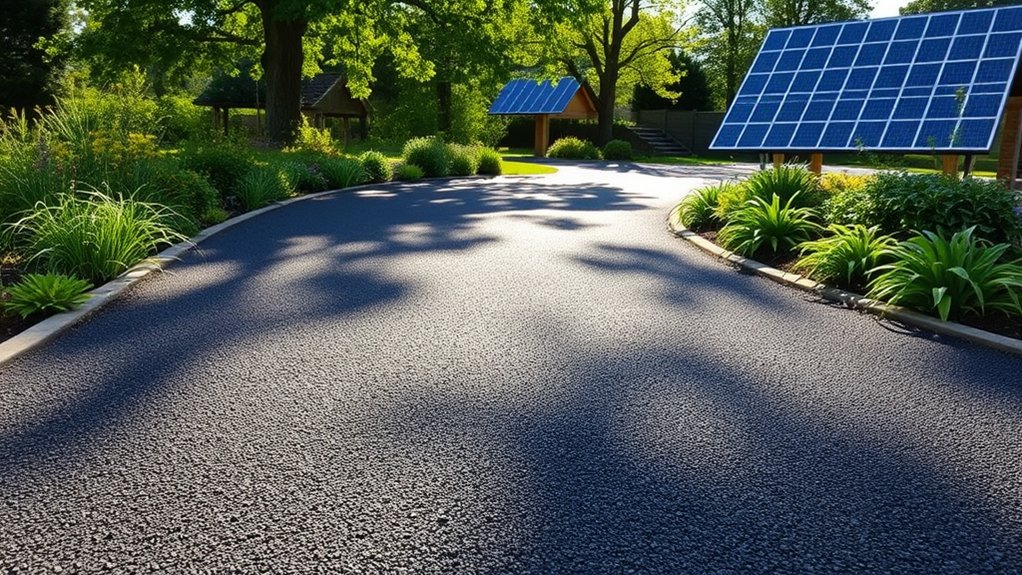
Choosing recycled tarmac for your driveway not only makes it more durable but also brings important environmental benefits. By using recycled materials, you help conserve natural resources and reduce the need to extract raw materials. This process uses less energy, leading to lower carbon emissions and a smaller ecological footprint. Additionally, using sustainable materials like recycled tarmac minimizes the carbon footprint of manufacturing construction materials.
Using recycled tarmac also aids in effective waste management by cutting down on asphalt waste in landfills, supporting a circular economy in construction. Furthermore, recycling helps minimise habitat disruption and pollution, which is vital for maintaining ecological balance. Engaging in these sustainable practices contributes to biodiversity and helps protect natural ecosystems, aligning with global efforts to combat climate change.
In short, using recycled tarmac is a practical choice that demonstrates your commitment to environmental responsibility and sustainable development.
Durability Compared to Traditional Asphalt
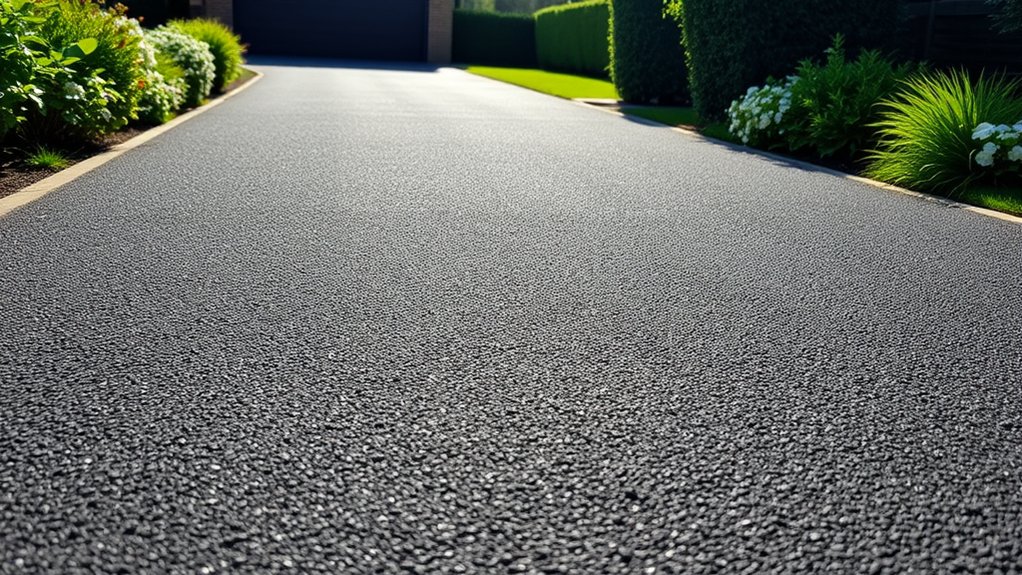
While traditional asphalt is often chosen for its visual appeal and reliability, recycled tarmac can match its durability and performance when correctly installed. Both materials are resilient, particularly against harsh weather and heavy traffic. Additionally, the use of reclaimed materials in recycled tarmac contributes to its sustainability and reduces the environmental impact of road construction.
| Feature | Recycled Tarmac |
|---|---|
| Composition | Reclaimed materials |
| Temperature Resistance | Excellent |
| Longevity | Comparable to asphalt |
| Traffic Wear | Minimal degradation |
| Cost-Effectiveness | Lower initial cost |
Recycled tarmac effectively manages temperature changes, resists cracking, and offers a stable surface. With proper installation and maintenance, both options can endure for many years, making recycled tarmac a sensible and eco-friendly choice.
Maintenance Requirements and Longevity
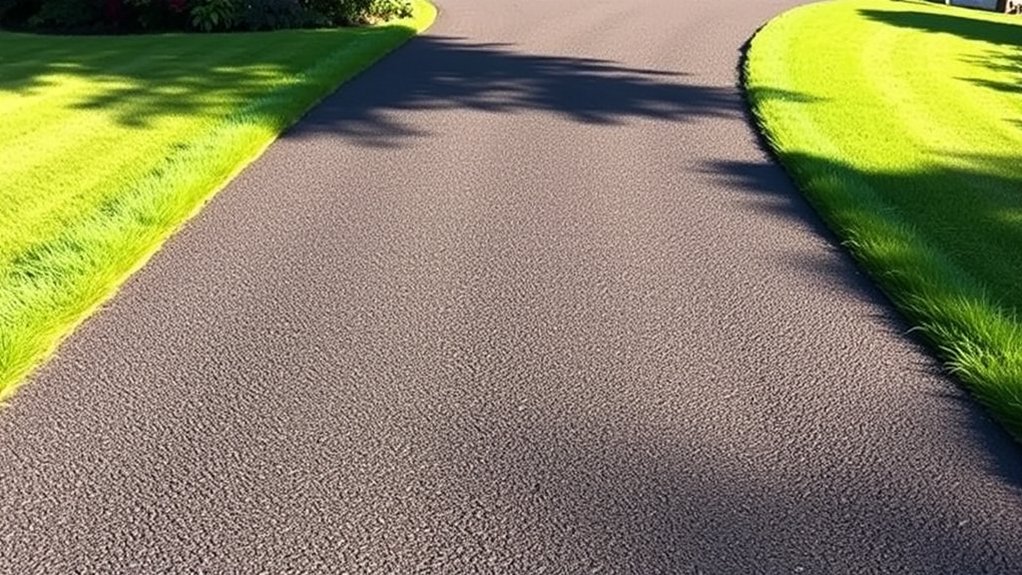
Recycled tarmac offers durability similar to traditional asphalt, but its longevity hinges on proper maintenance. To keep your driveway looking good and functioning well, establish a regular maintenance routine.
Start by cleaning it often to remove debris and prevent water build-up. Applying a sealant every three to five years will shield it from oxidation and erosion. Regularly check drainage to avoid damage, and quickly fill in small cracks with appropriate fillers.
For larger potholes, patching and compacting are necessary to ensure lasting durability. Keep in mind that environmental factors and traffic can impact its lifespan, but correct installation provides a solid foundation.
The good news is that maintenance costs are generally lower than those for traditional materials, making recycled asphalt a smart, eco-friendly choice for your driveway.
Aesthetic Considerations for Driveways
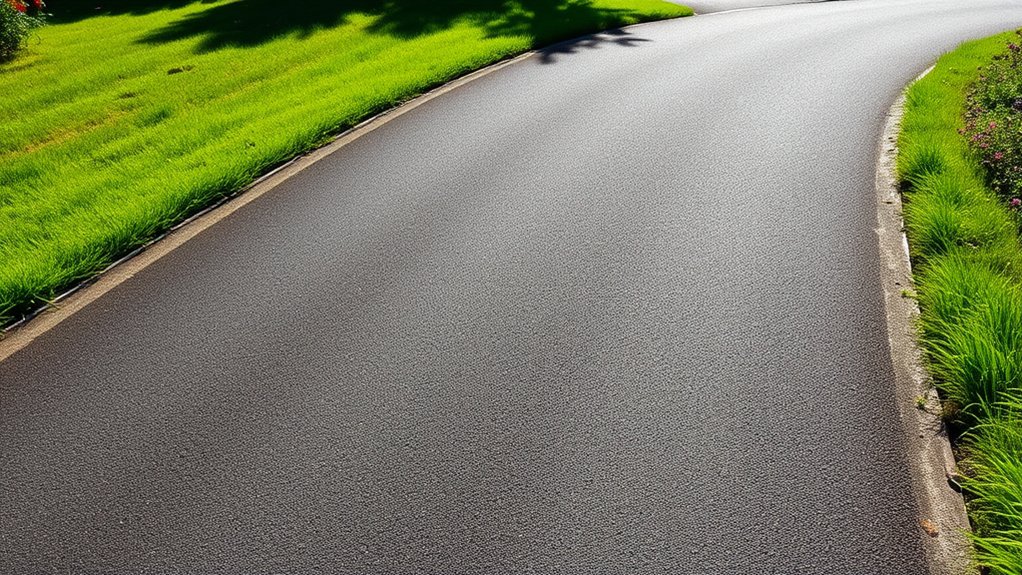
When considering the aesthetics of your driveway, recycled asphalt offers a distinct visual profile compared to traditional materials.
While it may not boast the striking black appearance or design flexibility of concrete or paving stones, its natural earthy tones can harmonise well with surrounding landscapes.
Assessing these visual elements can help you decide if recycled asphalt fits your aesthetic preferences and practical requirements.
Visual Appeal Factors
Selecting the right driveway material significantly influences your property’s visual appeal, and recycled tarmac offers distinct characteristics that can enhance your home’s look.
Its colour variations, typically ranging from dark grey to black, provide a unique alternative to standard asphalt. The textured finish of recycled tarmac creates a smooth surface that blends well with your garden.
While options for customisation are somewhat limited, the natural patterns of recycled materials can add character to your driveway. This minimalist style can complement your existing architecture and landscaping, boosting your home’s eco-friendly image.
Plus, its low maintenance ensures that the appearance stays consistent over time, making recycled tarmac an attractive and practical choice for homeowners.
Design Versatility Options
Design versatility is crucial for crafting a driveway that not only fulfills its functional role but also boosts your property’s visual appeal.
Recycled tarmac provides excellent options for integrating architectural features and enhancing design aesthetics.
Here are some ideas:
- Combine recycled tarmac with natural elements like grass or gravel for a unified appearance.
- Incorporate distinctive colour patterns and textures to enhance visual interest.
- Ensure seamless connections between pathways and driveways to promote landscape harmony.
Economic Advantages for Homeowners and Businesses

When considering recycled tarmac for driveways, you can expect substantial cost savings that benefit your budget.
It typically reduces installation costs by 40-60%. Plus, recycled asphalt is durable, leading to lower maintenance and repair expenses in the long run.
Additionally, using recycled materials helps reduce waste, which can save taxpayers money and conserve resources, highlighting the overall value of this choice.
Cost Savings Overview
Recycled tarmac offers substantial cost savings for both homeowners and businesses, making it a smart choice for paving projects.
A straightforward cost analysis shows that choosing recycled asphalt can result in:
- Lower material costs: Using reclaimed materials cuts down expenses compared to conventional asphalt.
- Reduced labour and transport costs: Easier installation and nearby recycling facilities help keep overhead low.
- Access to tax benefits: Many local councils provide incentives for using sustainable materials, making it even more affordable.
Long-Term Financial Benefits
Choosing recycled tarmac not only provides immediate cost savings but also offers significant long-term financial advantages for homeowners and businesses.
By using recycled asphalt, you can enjoy material costs that are 40-60% lower than traditional options, helping you stick to your budget. The durability of recycled asphalt means fewer repairs and a longer lifespan, making it easier to plan your finances.
With less maintenance needed, you’ll save money over time, and on-site recycling cuts down on transport costs. This eco-friendly choice conserves resources and strengthens your financial position, making it a wise investment for both residential and commercial projects.
Taxpayer Savings Impact
By opting for recycled tarmac, you not only improve the look of your property but also help save taxpayer money.
The benefits of using recycled asphalt include:
- Reduced construction costs: Recycled tarmac is more affordable than new asphalt, helping to lower your expenses.
- Energy savings: The recycling process requires less energy, which helps cut costs for taxpayers.
- Lower government spending: Widespread recycling of asphalt can save around £1.5 billion annually in the UK, positively affecting infrastructure budgets.
Additionally, using recycled tarmac contributes to environmental considerations by reducing resource depletion and harmful emissions associated with new asphalt production.
These financial benefits support both homeowners and businesses, allowing you to reinvest savings into your property or operations.
Performance in Various Weather Conditions
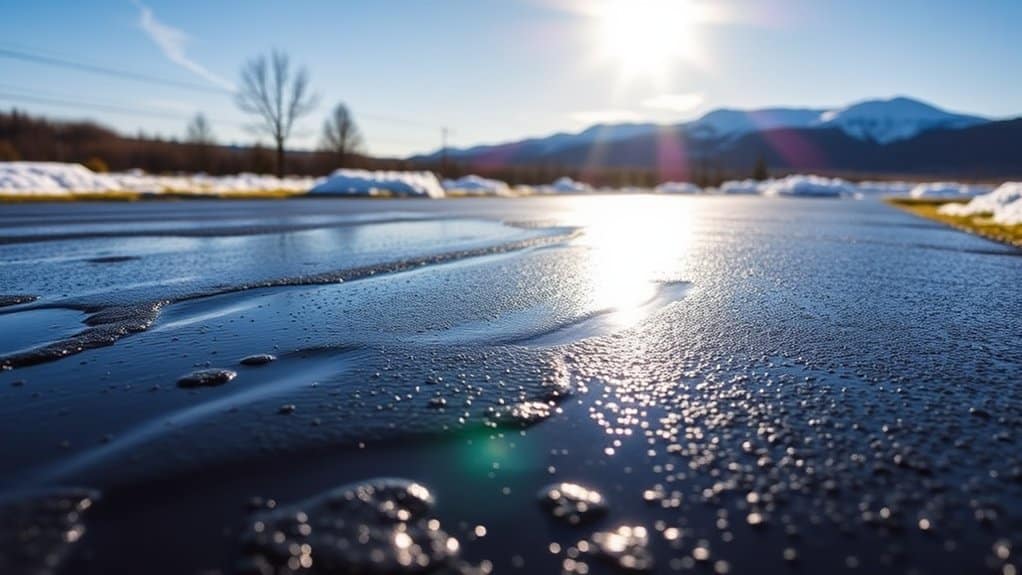
When choosing materials for your driveway, it’s crucial to consider how they perform in different weather conditions for lasting safety and durability.
Recycled tarmac stands out for its weather resilience. In winter, its dark surface absorbs heat, which helps melt snow and reduces ice formation, enhancing safety.
During heavy rain, its excellent permeability prevents flooding and minimises erosion, while ensuring a stable surface.
Even in high temperatures, recycled tarmac maintains its integrity without significant wear.
Its flexibility also provides resistance to freeze-thaw cycles, ensuring it lasts across all seasons. Additionally, proper drainage solutions can further enhance the performance of recycled tarmac by directing water away and preventing damage.
This combination of benefits not only cuts down on maintenance costs but also offers a sustainable option, making recycled tarmac a smart choice for your driveway.
Installation Best Practices for Recycled Tarmac

When installing recycled tarmac, ensuring proper surface preparation is crucial for durability and performance.
Focus on effective compaction techniques to create a solid base, as this significantly affects the lifespan of your driveway. For example, using a plate compactor can make a noticeable difference in stability.
Furthermore, scheduling regular maintenance will help identify any issues early, allowing you to extend the life of your installation and avoid costly repairs.
Proper Surface Preparation
Proper surface preparation is crucial for the durability and performance of recycled tarmac driveways. Here’s what to focus on:
- Clearing: Remove any debris, branches, and organic matter to avoid future problems.
- Base Layer: Create a solid foundation using crushed stone for good drainage and stability.
- Excavation: If needed, excavate the area to remove any existing pavement or debris, ensuring a clean base.
Compaction Techniques
With a solid foundation in place, we now turn to the crucial compaction techniques for installing recycled tarmac driveways.
Effective compaction is key, so using vibratory rollers or plate compactors will yield the best results. Lightly moistening the tarmac millings helps improve their flexibility during compaction.
Ensure you make multiple passes with your equipment to achieve thorough density and avoid weak spots. For thicker layers, compact in stages to ensure uniformity.
Establish consistent rolling patterns to prevent uneven surfaces. Regularly monitor the compaction process, checking for density and smoothness.
This proactive approach to moisture management will help create a durable and stable driveway, ensuring long-lasting performance.
Maintenance Scheduling
Maintaining a recycled tarmac driveway is essential for its longevity and performance. A proper maintenance schedule can help avoid costly repairs and improve its appearance.
Here’s a straightforward inspection checklist for your maintenance routine:
- Weekly Inspections: Check for visible cracks or signs of wear. Spotting issues early can save you money in the long run.
- Seasonal Sealant Application: Apply a sealant every one to three years to protect against the UK’s unpredictable weather.
- Drainage Checks: Conduct monthly checks to ensure proper drainage. This prevents water pooling, which can damage your driveway.
Keeping on top of these tasks will help keep your driveway in tip-top shape.
Future Trends in Sustainable Driveway Solutions
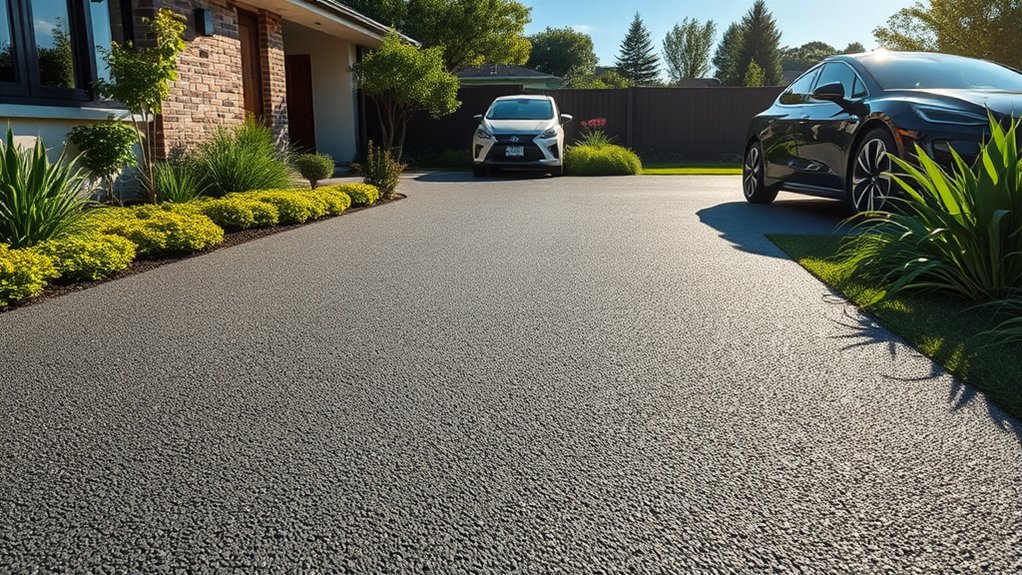
As sustainability becomes integral to modern construction, future trends in driveway solutions are leaning towards innovative materials and technologies that prioritize environmental care.
Expect to see a rise in sustainable options like permeable pavers and recycled asphalt, which improve stormwater management and lessen resource usage.
Innovations such as smart driveway systems and solar-powered lighting will enhance functionality while promoting energy efficiency.
Furthermore, incorporating greenery through grass driveway pavers can boost biodiversity and help cool urban areas.
These advancements reflect a commitment to building driveways that are durable, cost-effective, and environmentally friendly, ensuring that your choices benefit the ecosystem.
Comparison With Other Driveway Materials

Sustainable driveway solutions are becoming increasingly popular, and it’s essential to see how recycled tarmac measures up against other materials. Here’s a straightforward comparison:
- Cost-Effectiveness: Recycled tarmac is cheaper than new asphalt, concrete, and brick pavers, making it a wallet-friendly option for homeowners.
- Environmental Impact: Using recycled tarmac reduces the demand for new raw materials, resulting in a lower carbon footprint and less waste going to landfill.
- Durability: It provides similar durability to new asphalt, capable of handling heavy vehicles and performing well across different weather conditions.
Additionally, recycled tarmac maintains its long lifespan while requiring less maintenance, which enhances its appeal for both residential and commercial applications.
In summary, when weighing driveway options, recycled tarmac not only meets practical requirements but also supports eco-friendly practices. This makes it a wise choice for both residential and commercial use.
Frequently Asked Questions
Can Recycled Tarmac Be Used for Heavy-Duty Applications?
Yes, recycled tarmac can be used for heavy-duty applications. Its durability has been assessed and found to be on par with traditional materials, ensuring reliable performance even under significant loads. This makes it suitable for various industrial and infrastructure projects, such as roads, car parks, and loading bays.
How Does Recycled Tarmac Affect Property Value?
Consider your property as a blank canvas; using recycled tarmac can improve its aesthetic and potentially increase its resale value. Many buyers are drawn to eco-friendly options, making this choice not only sensible but appealing in the current market. For instance, a well-maintained driveway made from recycled tarmac can create a positive first impression and enhance curb appeal, which is crucial for attracting prospective buyers.
Is There a Smell Associated With Recycled Tarmac?
Recycled tarmac typically doesn’t have a strong smell unless certain additives are included. It offers a positive environmental impact by reducing waste and conserving resources, making it a sensible choice. While there may be mild scents during application, they are generally not overpowering.
Can I Install Recycled Tarmac Myself?
Yes, you can lay recycled tarmac yourself. Here are some straightforward tips: first, ensure the base is well-prepared; second, spread the material evenly during installation; and finally, compact it properly to achieve a durable surface that lasts.
What Colors Are Available for Recycled Tarmac Driveways?
When considering colour options for recycled tarmac driveways, you’ll find the choices quite limited. Typically, the shades are predominantly greyish, which allows them to blend in with the surroundings. However, they don’t offer the vibrant variety you might find with new asphalt alternatives. For instance, if you’re looking for something more colourful or distinctive, you may need to explore other materials.
Conclusion
In summary, choosing recycled tarmac for your driveway not only saves you money but also helps the environment. Using recycled asphalt can lower greenhouse gas emissions by as much as 20% compared to conventional materials. By selecting recycled tarmac, you’re opting for a durable, low-maintenance solution that boosts your property’s appearance while promoting eco-friendly practices. When considering driveway options, recycled tarmac is a sensible and responsible choice for today’s environmentally aware homeowner.
Practical, durable, and aesthetically pleasing, tarmac driveways offer unmatched benefits for UK homes—discover why they might be the perfect choice Read more
Fixing common tarmac driveway problems is essential for longevity; discover the best strategies to address cracks, potholes, and drainage issues Read more
Many homeowners wonder if tarmac driveway installation is a worthwhile DIY project, but the challenges might surprise you. Discover what Read more


